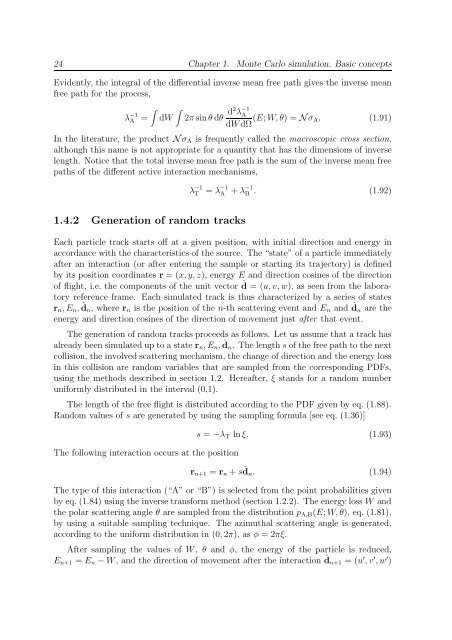PENELOPE 2003 - OECD Nuclear Energy Agency
PENELOPE 2003 - OECD Nuclear Energy Agency
PENELOPE 2003 - OECD Nuclear Energy Agency
Create successful ePaper yourself
Turn your PDF publications into a flip-book with our unique Google optimized e-Paper software.
24 Chapter 1. Monte Carlo simulation. Basic concepts<br />
Evidently, the integral of the differential inverse mean free path gives the inverse mean<br />
free path for the process,<br />
∫<br />
λ −1<br />
A =<br />
∫<br />
dW<br />
2π sin θ dθ d2 λ −1<br />
A<br />
dW dΩ (E; W, θ) = N σ A. (1.91)<br />
In the literature, the product N σ A is frequently called the macroscopic cross section,<br />
although this name is not appropriate for a quantity that has the dimensions of inverse<br />
length. Notice that the total inverse mean free path is the sum of the inverse mean free<br />
paths of the different active interaction mechanisms,<br />
λ −1<br />
T<br />
= λ −1<br />
A<br />
+ λ −1<br />
B . (1.92)<br />
1.4.2 Generation of random tracks<br />
Each particle track starts off at a given position, with initial direction and energy in<br />
accordance with the characteristics of the source. The “state” of a particle immediately<br />
after an interaction (or after entering the sample or starting its trajectory) is defined<br />
by its position coordinates r = (x, y, z), energy E and direction cosines of the direction<br />
of flight, i.e. the components of the unit vector ˆd = (u, v, w), as seen from the laboratory<br />
reference frame. Each simulated track is thus characterized by a series of states<br />
r n , E n , ˆd n , where r n is the position of the n-th scattering event and E n and ˆd n are the<br />
energy and direction cosines of the direction of movement just after that event.<br />
The generation of random tracks proceeds as follows. Let us assume that a track has<br />
already been simulated up to a state r n , E n , ˆd n . The length s of the free path to the next<br />
collision, the involved scattering mechanism, the change of direction and the energy loss<br />
in this collision are random variables that are sampled from the corresponding PDFs,<br />
using the methods described in section 1.2. Hereafter, ξ stands for a random number<br />
uniformly distributed in the interval (0,1).<br />
The length of the free flight is distributed according to the PDF given by eq. (1.88).<br />
Random values of s are generated by using the sampling formula [see eq. (1.36)]<br />
The following interaction occurs at the position<br />
s = −λ T ln ξ. (1.93)<br />
r n+1 = r n + sˆd n . (1.94)<br />
The type of this interaction (“A” or “B”) is selected from the point probabilities given<br />
by eq. (1.84) using the inverse transform method (section 1.2.2). The energy loss W and<br />
the polar scattering angle θ are sampled from the distribution p A,B (E; W, θ), eq. (1.81),<br />
by using a suitable sampling technique. The azimuthal scattering angle is generated,<br />
according to the uniform distribution in (0, 2π), as φ = 2πξ.<br />
After sampling the values of W , θ and φ, the energy of the particle is reduced,<br />
E n+1 = E n − W , and the direction of movement after the interaction ˆd n+1 = (u ′ , v ′ , w ′ )
















